People
Szabolcs Bozó’s Adorable Creatures Were an Antidote to Lockdown Blues. Now They’re Fetching Six-Figure Sums at Auction
The artist’s “kawaii-”style paintings have won him fans in Asia.
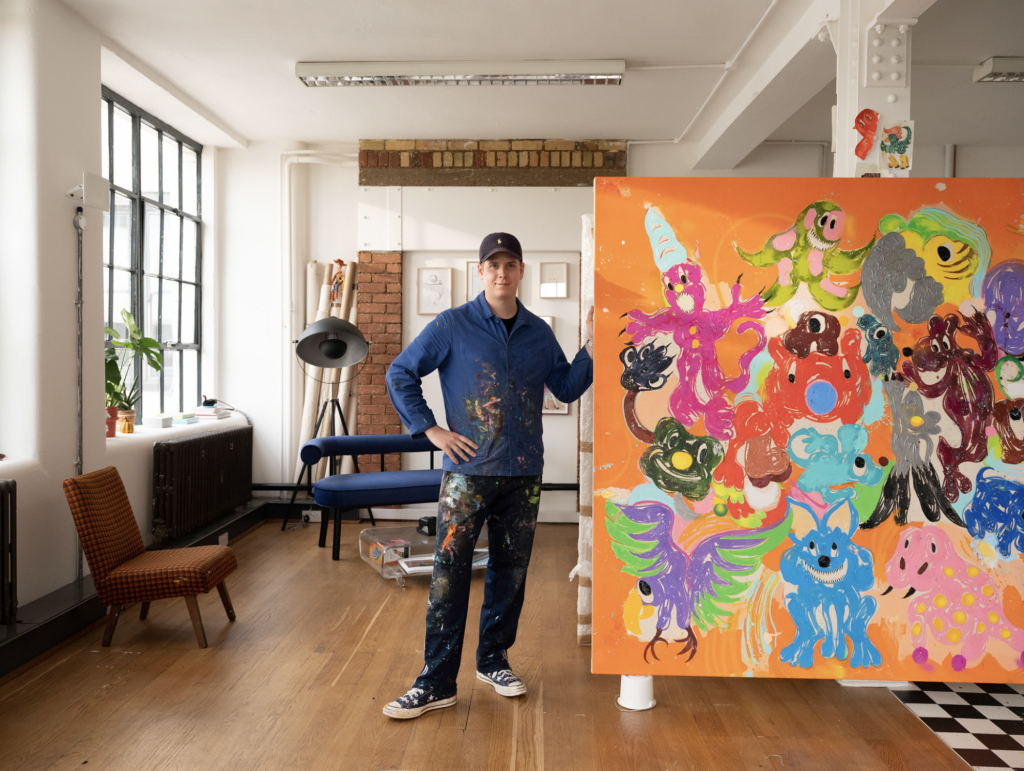
The artist’s “kawaii-”style paintings have won him fans in Asia.

Lucy Howie

Joy, play and imagination are important to Szabolcs Bozó. Known among friends as “Szabi,” the young Hungarian artist’s vivid paintings of cute animal characters speak to his appetite for fun.
“Selfishly, I make things to keep myself excited and happy,” the artist told me early on a Monday morning, before he headed to his East London studio for the day. It just so happens that they are also selling for vast sums at auction.
Bozó is one of London’s most successful young emerging artists, despite creating his first large-scale paintings of colorful cartoon-ish creatures only a few years ago. While the prices have not reached the heights of market darlings who star in the main evening sales, he is among a cohort of artists who have quietly enjoyed a meteoric rise in the international art market while having had little institutional or media attention to their work.
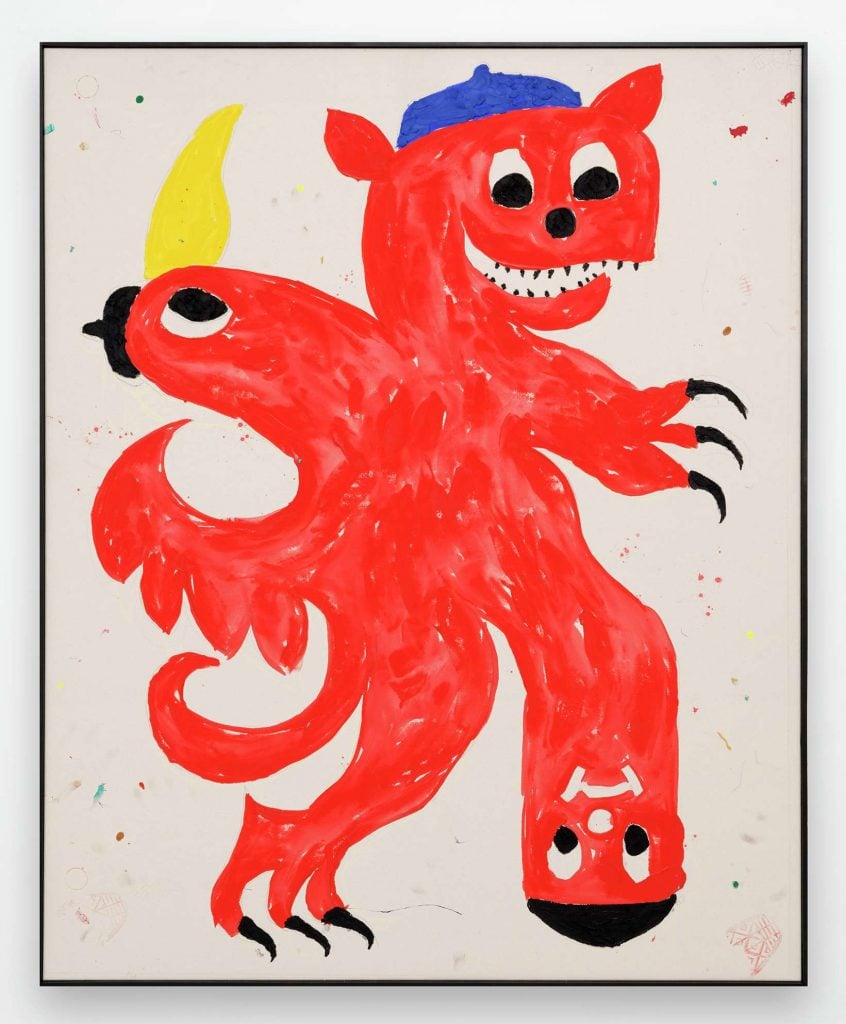
Szabolcs Bozó, Operator, (2020). Courtesy of the artist and Semiose.
The artist’s journey began when he moved to London in 2011 from his hometown Pécs in Hungary when he was just 19, not to paint, but to learn English. While working as a waiter in a London restaurant, he produced hundreds of cartoon drawings on his order pad. Between 2013 and 2018, he translated his hobby into a larger format, working from a studio above the restaurant, creating his googly-eyed paintings for fun and posting his works onto Instagram—but buyers will find none of these works on the market.
“My only works on the market are from 2018 onwards. This is because I was making a lot of paintings in my room above the restaurant up until this point, but I never planned to sell them. Most of my works from before 2018 are now destroyed because I repainted them when I couldn’t afford new canvases,” Bozó explained.
All that changed in 2018, when a Spanish gallerist found his paintings on Instagram and flew him to Mallorca for an artist residency. After that, “I just kept making new works and everything just flowed from that,” he said.
Bozó’s fantastical paintings are now highly sought after on the primary and secondary international art market. Entrepreneur and founder of WOAW Gallery, Kevin Poon, is an enthusiastic supporter who first came across Bozó’s mythical characters online during the COVID-19 pandemic. “You have to try really hard to be able to buy one of Szabi’s paintings,” he explained, “I was lucky enough to visit his studio back in 2021, and commissioned a piece by him last year.” Poon’s commission, The Last Supper now adorns a restaurant in Central Hong Kong.
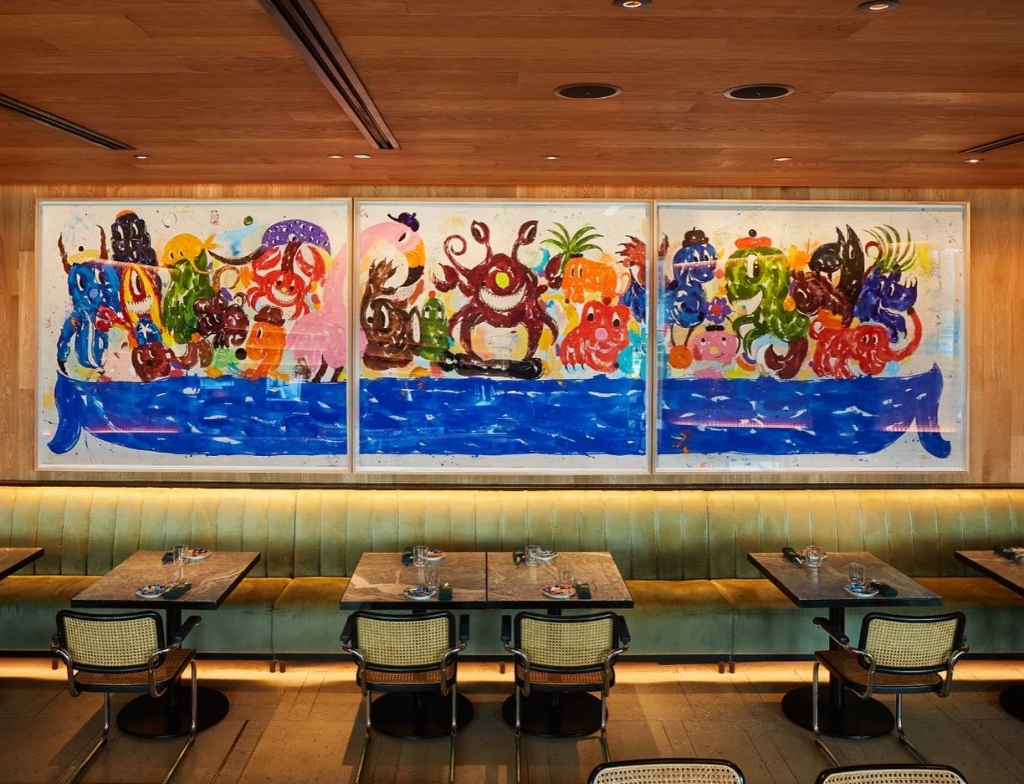
Szabolcs Bozó, The Last Supper. Courtesy Kevin Poon.
Describing Bozó’s works, gallerists set him apart from his peers by emphasizing the influence of the history of Hungarian folklore and tradition that infused cartoons produced by the state’s national animation studio Pannónia, under Communism, through the 1950s until the 1980s. However, the artist himself is reluctant to dwell on the socio-political analysis of his lively figures, explaining that, “these characters just come from my imagination and they make me happy. I guess, I grew up with these traditional animations in Hungary, but it was never a conscious influence for me.”
Poon puts the appeal of the light-hearted work into better context. “Since the pandemic, the market for figurative and whimsical styles has grown significantly,” he told me, adding that collectors are seeking out healing and carefree artworks. Bozó’s uplifting paintings, imbued with an air of nostalgia, embody this sentiment in their vibrant colors and bold, painterly strokes.
The artist got his break with a solo show was at Semiose Gallery in Paris, during the summer of 2020. The artist describes the show, aptly titled “Big Bang,” as happening “at the right time in the right place,” coinciding with the first easing of COVID-19 restrictions. From stark and depressing times in 2020, Bozó’s works appeared in the gallery space and circulated Instagram with a sense of optimism and childlike intuition.
Bozó’s goofy figures struck just the right note with collectors, and he went on to get solo exhibitions in London with Carl Kostyal to Brussels with Almine Rech. In the same year, he also participated in group exhibitions with other emerging artists in Shanghai with Almine Rech and Hong Kong and Singapore with WOAW Gallery, further developing his reputation in Asia. The artist gained major popularity later in 2022, when he held two solo exhibitions in the M Woods Museum, Beijing and Sifang Satellite Space, Shanghai.
Bozó’s remarkable performance at auction over the last year shows that collectors have also been capitalizing on the appetite for his playful paintings. His artworks appeared for sale at public auction a whopping 34 times in 2022, generating a total sales value of $1.5 million. By contrast in 2021, Bozó’s work only came to auction once. Since then, 50 percent of the artist’s paintings that sold at auction went under the hammer for above their high estimates, with the average sale price of his works in 2022 sitting at $50,156.
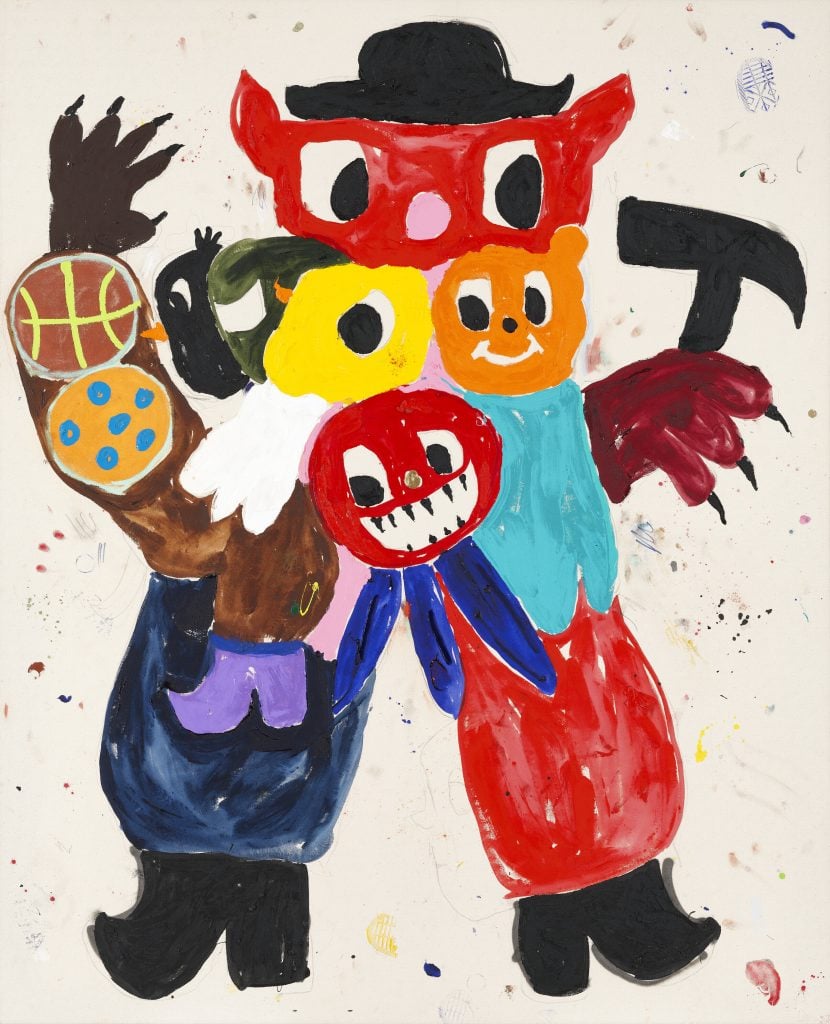
Szabolcs Bozó, Untitled (2020). Courtesy Christie’s Images Limited 2023.
Anyone who nabbed a painting at auction before 2020 paid prices ranging between $2,000 and $10,000, while on the current primary market Bozó’s paintings will set a collector back between $30,000 and $50,000.
His auction record was set in May at Christie’s 21st Century Art day sale in Hong Kong, where Untitled (2020) sold for $176,572 (HK$1,386,000). Depicting a bizarre monstrous creature, with small googly-eyed animals attached to its body, this painting sold for an eye-watering 1140 percent above its high estimate of HK$90,000.
Sihan Hu, the house’s associate specialist for 20th and 21st century art explained that, “the overwhelmingly positive atmosphere of the art market” at the time was one key contributing factor. The sale also coincided with a time when the work was nearly impossible to buy on the primary market, and it helped that this example was the first large-scale, multi-animal painting to come to auction. “It was an instant favorite amongst collectors,” Hu said, adding that others that hit the block in 2022 were “comparatively less colorful and comprised of single animal paintings.”
Since that high watermark, work has continued to perform well at auction, with a red flamingo painting bringing in $162,544 (HK$ 1,008,000) at Sotheby’s Hong Kong in June, and an eccentric pink bird generating $92,498 (£75,600) at Phillips London in December.
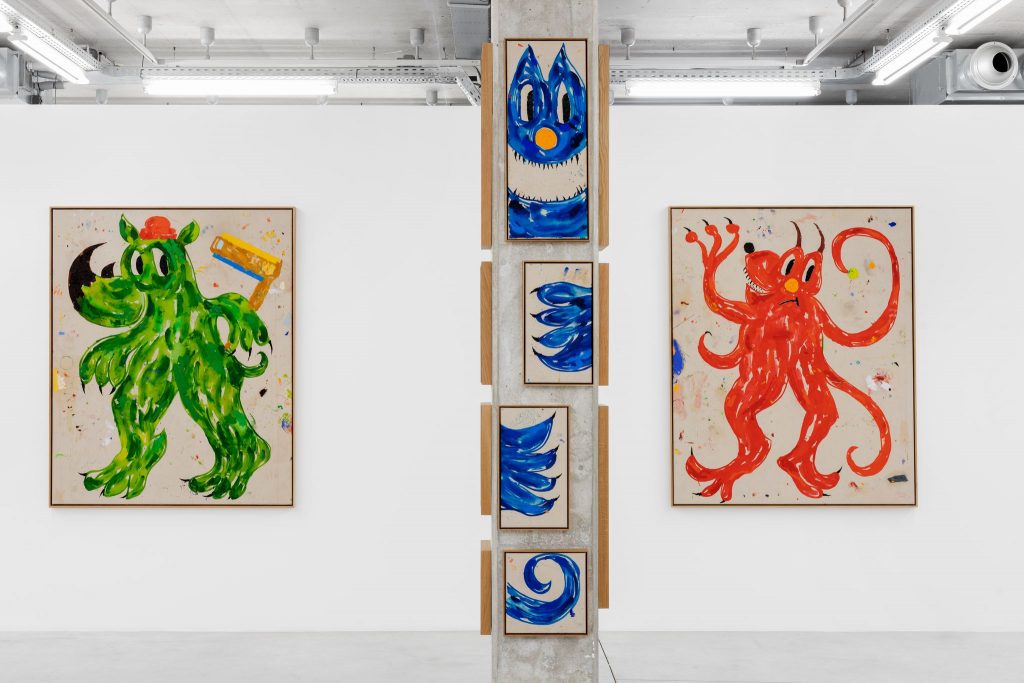
Szabolcs Bozó, The Hug of the Krampus. Exhibition view: “Szabolcs Bozó, Busójárás (Carnival),” Almine Rech, Brussels (9 December 2021—15 January 2022). Courtesy the Artist and Almine Rech. Photo: Huggard & Vanoverschelde Photography.
Aged just 30, Bozó’s artistic aspirations are growing more complex and larger in scale. He is in the midst of preparing for an ambitious solo show with Almine Rech at Palazzo Cavanis in Venice this summer. He has been studying the floor plans of the grandiose architecture as he ponders how to respond to it with his paintings. “If I see something interesting in the architecture, I like to play with the space and involve it in the exhibition,” he said. As his works move into new areas of complexity, architecture and landscape will play a big role, something that is already apparent in works like The Hug of the Krampus (2021) and Epping Forest (2022).
This year he is looking forward to some more focused work in his studio, hopefully under less pressure to produce, he said: “I want to take a bit more time with my work.” But the exhibitions continue to rack up; before his solo show in Venice, Bozó will also be showing at the Marfa Invitational with Carl Kostyal in Texas in May.
Despite a shrinking economy in 2023, Bozó’s largely Asian collector base continues to boost his market success. The overall economy in Asia is now recovering and Bozó’s works are in great demand, with works headed for sale in New York, London, and Tokyo this month alone. But the artist seems to block out this noise, heading to his studio for peace and quiet. “I try to go there and enjoy making paintings without emails or Instagram,” he remarked. “This is how I remember going to work with my father, listening to the radio, and feeling like no one is watching me.”